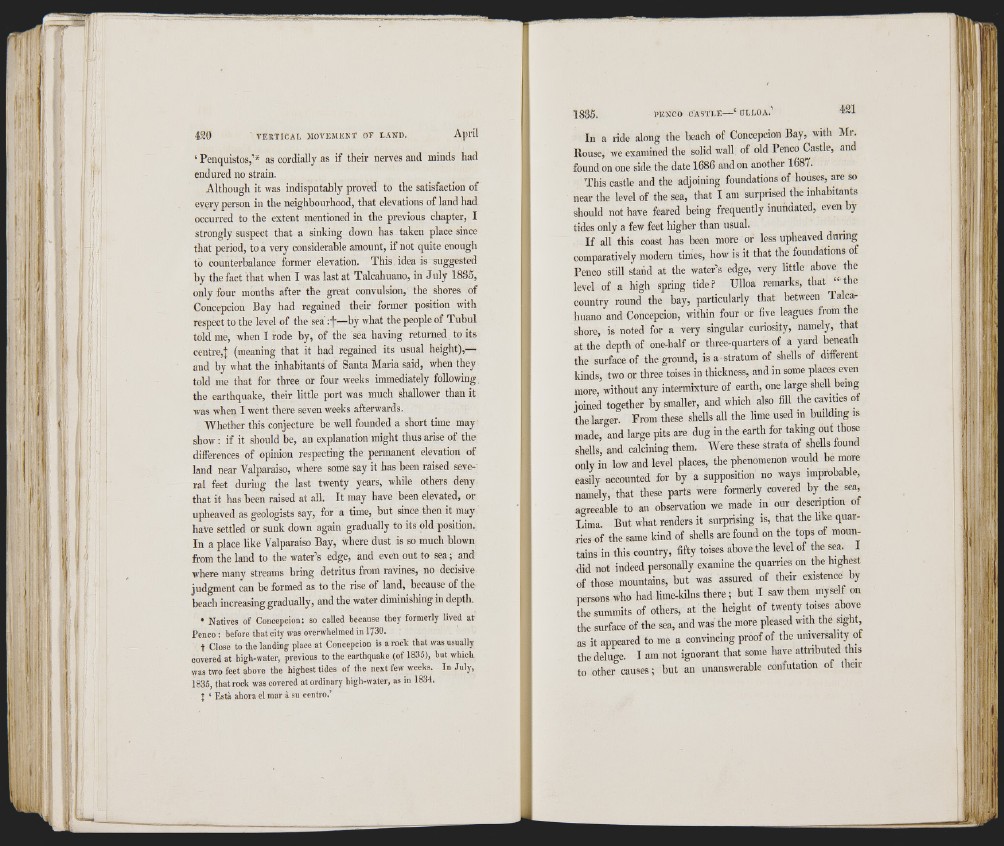
■ 'll{l
I , i !
!l'
! ¡
■ 'Vf
■ l:l
' !■ 0f
r H]
)i l ì
0. \[
420 VERTICAI . MOVEMENT OF LAND. April
‘ Penquistos,’* as cordially as if their nerves and nninds had
endured no strain.
Although it was indisputably proved to the satisfaction of
every person in the neighbourhood, that elevations of land had
occurred to the extent mentioned in the previous chapter, I
strongly suspect that a sinking down has taken place since
that period, to a very considerable amount, if not quite enough
to counterbalance former elevation. This idea is suggested
by the fact that when I was last at Talcahuano, in July 1885,
only four months after the great convulsion, the shores of
Concepcion Bay liad regained their former position with
respect to the level of the sea ty—by what the people of J ubul
told me, when I rode by, of the sea having returned to its
centre,] (meaning that it had regained its usual height),—
and by what the inhabitants of Santa Maria said, when they
told me that for three or four weeks immediately following
the earthquake, their little port was much shallower than it
was when I went there seven weeks afterwards.
Whether this conjecture be well founded a short time may
show : if it should be, an explanation might thus arise of the
differences of opinion respecting the permanent elevation of
land near Valparaiso, where some say it has been raised several
feet during the last twenty years, while others deny
that it has been raised at all. It may have been elevated, or
upheaved as geologists say, for a time, but since then it may
have settled or sunk down again gradually to its old position.
In a place like Valparaiso Bay, where dust is so much blown
from the land to the water’s edge, and even out to sea ; and
where many streams bring detritus from ravines, no decisive
judgment can be formed as to the rise of land, because of the
beach increasing gradually, and the water diminishing in depth.
• Natives of Concepcion: so called hecause they formerly lived at
Penco : before that city was overwhelmed in 1730.
t Close to the landing place at Concepcion is a rock that was usually
covered at high-water, previous to the earthquake (of 1835), but which
was two feet above the highest tides of the next few weeks. In July,
1836, that rock was covered at ordinary high-water, as in 1834.
t ‘ Està ahora el mar à su centro.’
In a ride along the beach of Concepcion Bay, with Mr.
Rouse, we examined the solid wall of old Benco Castle, and
found on one side the date 1686 and on another 1687.
This castle and the adjoining foundations of houses, are so
near the level of the sea, that I am surprised the inhabitants
should not have feai'ed being frequently inundated, even by
tides only a few feet higher than usual.
I f all this coast has been more or less upheaved during
comparatively modern times, how is it that the foundations o
Penco still stand at the water’s edge, very little above the
level of a high spring tide ? Ulloa remarks, that “ the
country round the bay, particularly that between Talcahuano
and Concepcion, within four or five leagues from the
shore, is noted for a very singular curiosity, namely, that
at the depth of one-half or three-quarters of a yard beneath
the surface of theground, is a stratum of shells of different
kinds, two or three toises in thickness, and in some places even
more, without any intermixture of earth, one large shell being
ioined together by smaller, and which also fill the cayties of
the larger. Prom these shells all the lime used in building is
made, and large pits are dug in the earth for taking out those
shells, and calcining them. Were these strata of shells found
only in low and level places, the phenomenon would be more
easily accounted for by a supposition no ways improbable,
namely, that these parts were formerly covered by the sea
agreeable to an observation we made in our description ot
Lima But what renders it surprising is, that the like quarries
of the same kind of shells are found on the tops of mountains
in this country, fifty toises above the level of the sea I
did not indeed personally examine the quarries on the highest
of those mountains, but was assured of their existence by
persons who had lime-kilns there ; but I saw them myself on
{he summits of others, at the height of twenty toises abore
the surface of the sea, and was the more pleased with the sight,
as it appeared to me a convincing proof of the universality of
the deluge. I am not ignorant that some have attoibuted this
to other causes; but an unanswerable confutation of their